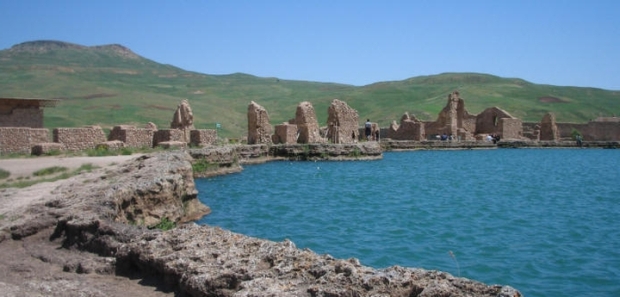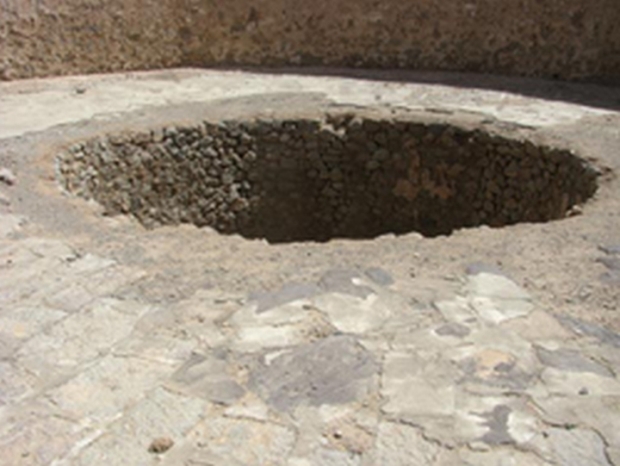High in the mountains of northern Iran lie the time-ravaged ruins of an ancient city: it is the most holy site of a pre-Islamic religion, three of whose priests paid homage to the infant Jesus. A great lake 330ft (100m) across lies at the heart of the ruined Sassanian city of Shiz, known to the Mongols as Saturiq and now known as Takht-I Sulaiman (The Throne of Solomon). The waters of this pool, reputed to be bottomless are rich in minerals and their ceaseless flow over millennia has caused a build-up of deposits. These have formed an oval platform around the lake rising about 200ft (60m) above the surrounding valley. Stone channels and small streams course down its sides. Until the coming of Islam, this mysterious and beautiful lake and its surroundings were regarded as the principal religious site in Iran. And in the 1970s excavations by the German Archaeological Institute proved that Takht-I Sulaiman was indeed the sacred centre of Zoroastrianism – an ancient religion based on the concept of the eternal struggle between the god of creation and the spirit of evil.

The Three Wise Men, or Magi, who were said to have travelled from Saveh in Iran to pay homage to the infant Jesus in Bethlehem, were likely to have been Zoroastrian priests (the Magi were originally members of a north-west Iranian tribe). From Magi comes the word ‘magic’ once used to describe the religious rites of Zoroastrianism.
The connection between Takht-i-Sulaiman and Zoroastrianism provides an important physical link with the past for the remaining adherents of the religion, thought to number some 200,000. The Zoroastrians left Persia in the eight century to escape religious persecution by the Muslims, and contact with their Iranian counterparts was only re-established in the 15th century. Today they are known as Parsees (Persians), and live mainly in Pakistan and India, but with followers scattered around the globe.
The history of Takht-i-Sulaiman and the rise of Zoroastrianism are intertwined and begin with Iran’s ancient founders, the Aryans (Iran means ‘land of the Aryan’). The Aryans revered the natural elements, especially fire and water, as manifestations of their gods. Thus the area around Takht-i-Sulaiman, which possessed two powerful earthly phenomena – volcanoes and thermal spring-fed lakes – was particularly important to them.
In about 600 BC, an Aryan priest named Zarathustra (known in Greek as Zoroaster), who saw himself as a prophet, attempted to redefine Aryan religious belief with its many gods. Breaking away from orthodoxy, Zarathustra established his own faith, which became known as Zoroastrianism. The new religion contained the beginnings of monotheism: Zarathustra considered Ahura Mazda Lord of Wisdom, to be the supreme god who, helped in his task by lesser divinities, is destined eventually to win his struggle against the Evil One, Angra Mainyu. Zarathustra preached that Man’s duty is to choose for himself where he stands in this struggle between good and evil and his soul will be judged in the hereafter.
Several important aspects of the old religion became part of the new. Fire, as the symbol of Ahura Mazda, remained sacred, and was tended on the family hearth as well as in the temples. A Parsee priest covers his mouth to prevent his breath from contaminating the fire. Every religious rite must be conducted by a priest. The priesthood is hereditary, no one born into a lay family can become a priest. Zoroastrians also went to great lengths to avoid defiling the elements and this was particularly illustrated in their attitude to death.

Bodies could not be buried for fear of contaminating the earth, nor could they be burned since to do so would sully the fire. Instead, large round stone-faced towers, called dakhmes, meaning towers of silence, were built, on top of which the dead were laid out naked. During this rite of exposure, the corpses were picked clean of their flesh by vultures, and the sun’s rays ‘drew the bodies’ spirits heavenwards’. This ritual is still practiced by Parsees today.

The holy book of the Zoroastrians, the Avesta, includes plans for the way in which the dead should be placed on a dakhme. Men’s bodies were laid out on one side, women’s on the other. Once the bones had been picked clean, they were thrown down a central well.
With the accession of the Sassanian dynasty in the third century AD, under the rule of King Ardashir I, who was a member of the priest class, Zoroastrianism became Iran’s state religion. Altars with perpetually burning fires were set up all over the country. Some, crowning rocky heights, burned in the open air. Others were enclosed in fire temples called Chahar taq, meaning ‘four arches’, after their basic plan – a square marked by four pillars joined by arches and crowned by a dome.
Nearly every town, village and province n Iran had its own sacred fire. There were different categories of fire, too: Atur Gushnasp was the fire of warriors and kings; Atur Burzen-Mihr was the fire of farmers; and Atur Farnbag the fire of priests. Today, only the location of Atur Gushnasp, the Royal Fire, is precisely known – its divine flames burned in the fire temple at the site of Takht-i-Sulaiman. The temple ruins are today reflected in the waters of the pool around which the ancient city stood.
The Sassanian king Khusrau I (AD 531-79) refurbished the fire temple and built a city on the already established religious site. He had previously built a palace at Ctesiphon, on the River Tigris, so fantastic that folklore held it to have been constructed by genies. Now he established Takht’i-Sulaiman as Iran’s foremost place of pilgrimage and worship. Khusrau planned with precision and flair; he gave Takht-i-Sulaiman a processional way which ran straight from a spectacular entrance at the north gate hrough to the fire temple and on to the lake. After their glorious coronation at Ctesiphon, the Sassanian kings made a pilgrimage to Takht-i-Sulaiman to receive a divine investiture at the altar of the Royal Fire.
But Khusrau’s vision was not everlasting. Takht-i-Sulaiman was sacked in AD 627 and, although later rebuilt by the Mongols, never regained its former glory. The Royal Fire had been extinguished, Islam was imposed the state religion, and eventually this most spectacular of sacred sites was reduced to the desolate ruins visible today.



































